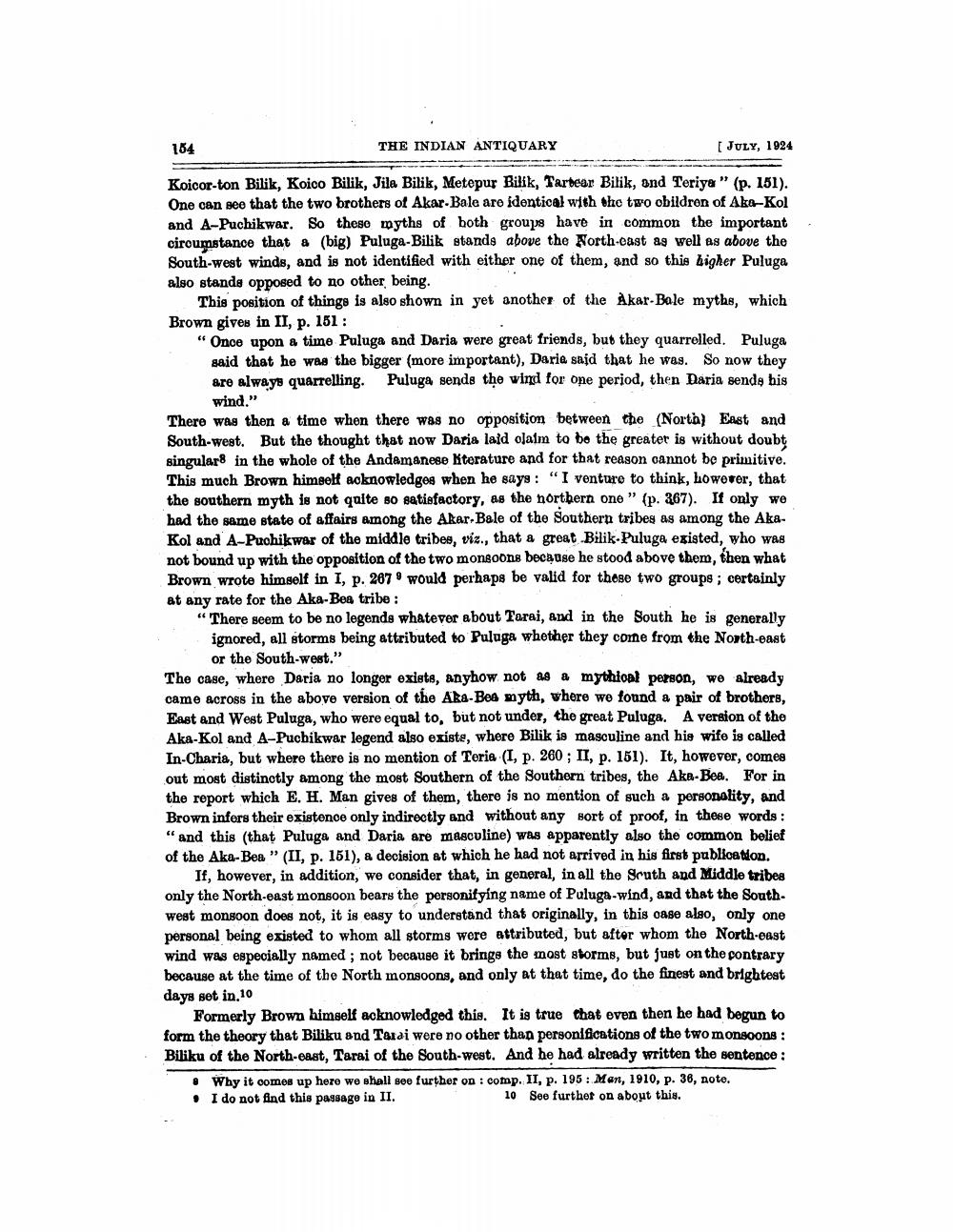________________
184
THE INDIAN ANTIQUARY
[ JULY, 1924
Koicor-ton Bilik, Koico Bilik, Jila Bilik, Metepur Bilik, Tarbear Bilik, and Teriya" (p. 151). One can see that the two brothers of Akar-Bale are identical with the two obildron of Aka-Kol and A-Puchikwar. So these myths of both groups have in common the important ciroumstanoo that a (big) Puluga-Bilik stands above the North-east as well as above the South-west winds, and is not identified with either one of them, and so this higher Puluga also stands opposed to no other being.
This position of things is also shown in yet another of the Akar. Bale myths, which Brown gives in II, p. 151 :
"Once upon a time Puluga and Daria were great friends, but they quarrolled. Puluga
said that he was the bigger (more important), Daria said that he was. So now they are always quartelling. Puluga sends the wind for one period, then Daria sends his
wind.” There was then a time when there was no opposition between the (North) East and South-west. But the thought that now Daria laid olaim to be the greater is without doubt singular in the whole of the Andamanese Kiterature and for that reason cannot be primitive. This much Brown himself acknowledges when he says: "I venture to think, however, that the southern myth is not quite so satisfactory, as the northern ono" (p. 367). It only we had the same state of affairs among the Akar-Bale of the Southern tribes as among the AkaKol and A-Puohikwar of the middle tribes, viz., that a great Bilik Puluga existed, who was not bound up with the opposition of the two monsoons because he stood above them, then what Brown wrote himself in I, p. 207 would perhaps be valid for those two groups; certainly at any rate for the Aka-Bea tribe :
“There seem to be no legends whatever about Tarai, and in the South he is generally
ignored, all storms being attributed to Puluga whether they come from the North-east
or the South-west." The case, where Daria no longer exists, anyhow not 49 a mythioal person, we already came across in the above version of the Aka-Bea myth, where we found a pair of brothers, East and West Puluga, who were equal to, but not under, the great Puluga. A version of the Aka-Kol and A-Pucbikwar legend also existe, where Bilik is masculine and his wife is called In-Charia, but where there is no mention of Teria (1, p. 260 ; II, p. 151). It, however, comes out most distinctly among the most Southern of the Southern tribes, the Aka-Bea. For in the report which E. H. Man gives of them, there is no mention of such a personality, and Brown infers their existence only indirectly and without any sort of proof, in these words: "and this (that Puluga and Daria are masculine) was apparently also the common belief of the Aka-Bea" (II, p. 151), a decision at which he had not arrived in his first publication.
If, however, in addition, we consider that, in general, in all the Sruth and Middle tribes only the North-east monsoon bears the personifying name of Pulugt-wind, and that the South. west monsoon does not, it is easy to understand that originally, in this case also, only one personal being existed to whom all storms were attributed, but after whom the North-east wind was especially named ; not because it brings the most storms, but just on the contrary because at the time of the North monsoons, and only at that time, do the finest and brightest days set in 10
Formerly Brown himself acknowledged this. It is true that even then he had begun to form the theory that Biliku and Tazai were no other than personifications of the two monsoons : Biliku of the North-east, Tarai of the South-west. And he had already written the sentence :
Why it comes up here we shall see further on : comp. II, p. 195: Man, 1910, p. 36, noto. . I do not find this passage in II.
10 See further on about this.




